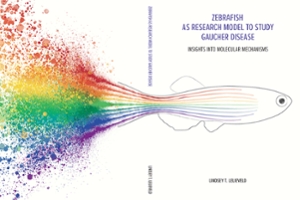Proefschrift
Zebrafish as vertebrate model of Gaucher disease
Lysosomal storage disorders (LSDs) are a group of orphan diseases characterized by lysosomal dysfunction or impaired lysosomal catabolism and affect collectively about 1 in 5000 live births.
- Auteur
- Lelieveld, L.T.
- Datum
- 20 oktober 2020
- Links
- Thesis in Leiden Repository

Lysosomal storage disorders (LSDs) are a group of orphan diseases characterized by lysosomal dysfunction or impaired lysosomal catabolism and affect collectively about 1 in 5000 live births. A common LSD is Gaucher disease, which is characterized by a defect in glucocerebrosidase (GCase) degrading glucosylceramide (GlcCer) in lysosomes. In this thesis, the zebrafish is evaluated as vertebrate animal model for the investigation of lysosomal storage disorders, in particular Gaucher disease. Zebrafish are an appealing model organism to study genetic disorders with a high evolutionary conservation of genes and proteins compared to humans, easy maintenance and simple genetic and pharmacological manipulation. Zebrafish larvae are of particular use as zebrafish can generate hundreds of off-spring which have a rapid embryonal development, are transparent and fit in a 96-wells plate. In this thesis several biochemical and genetic techniques have been developed in order to 1) compare the catalytic features of zebrafish GCase with human GCase, 2) investigate the consequences of its defect in zebrafish larvae and adults as well as a concomitant defect in non-lysosomal GBA2 and 3) study the potential toxicity of excessive glucosylsphingosine during GCase deficiency as consequence of a defect in lysosomal acid ceramidase. GCase-deficient zebrafish showed similar symptoms and affected molecular mechanisms as patients and mouse models. Therefore the zebrafish offers exciting new possibilities to study molecular mechanisms underlying pathological processes during lysosomal hydrolase deficiencies.
